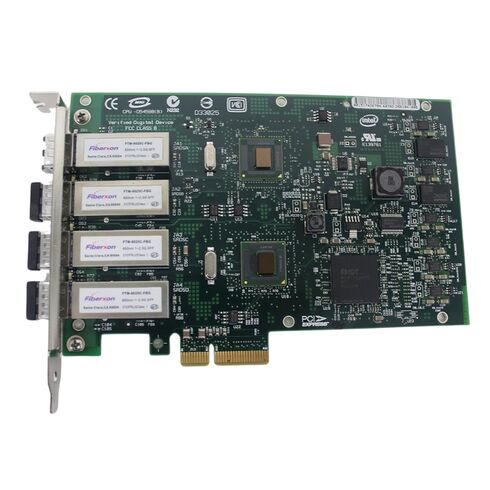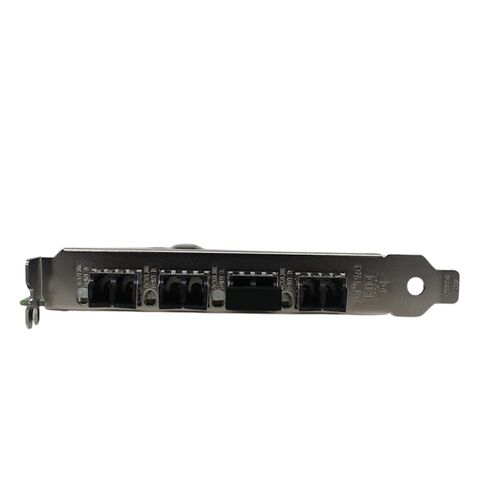EXPI9404PF Intel Server Adapter 4-Port Gigabit Ethernet PCI Express x4
- — Free Ground Shipping
- — Min. 6-month Replacement Warranty
- — Genuine/Authentic Products
- — Easy Return and Exchange
- — Different Payment Methods
- — Best Price
- — We Guarantee Price Matching
- — Tax-Exempt Facilities
- — 24/7 Live Chat, Phone Support
- — Visa, MasterCard, Discover, and Amex
- — JCB, Diners Club, UnionPay
- — PayPal, ACH/Bank Transfer (11% Off)
- — Apple Pay, Amazon Pay, Google Pay
- — Buy Now, Pay Later - Affirm, Afterpay
- — GOV/EDU/Institutions PO's Accepted
- — Invoices
- — Deliver Anywhere
- — Express Delivery in the USA and Worldwide
- — Ship to -APO -FPO
- — For USA - Free Ground Shipping
- — Worldwide - from $30
Product Overview Of Intel EXPI9404PF
Hardware Specifications
- Device Type: High-performance network adapter with four ports.
- Form Factor: Compact plug-in card for streamlined installation.
- Interface: PCI Express X4, adhering to PCIe 1.0a standards for compatibility.
Advanced Networking Capabilities
- Connectivity: Reliable wired technology for robust performance.
- Cabling Type: Supports Ethernet 1000BASE-SX for seamless multi-mode fiber connections.
- Data Protocols: Facilitates Gigabit Ethernet with efficient TCP/IP and UDP/IP support.
- Remote Management: Includes SNMP and DMI 2.0 for effortless network oversight.
Performance-Enhancing Features
- Fault Tolerance: Ensures uninterrupted connectivity under demanding conditions.
- Load Balancing: Optimizes traffic distribution across ports.
- ACPI Support: Enhances power management and system efficiency.
- VLAN Support: Enables secure and segregated network configurations.
- Wake on LAN (WoL): Supports remote system activation.
Compliance and Standards
- IEEE Standards: Conforms to IEEE 802.3u, 802.3z, 802.1Q, 802.3ab, and 802.1p protocols.
- Transport Protocols: Compliant with IEEE 802.3x for flow control and IEEE 802.3ad for link aggregation.
- Industry Certification: Adheres to WFM 2.0 guidelines for manageability.
Processor and Memory
- Chipset: Powered by the robust Intel 82571GB processor for enhanced networking performance.
Expansion and Connectivity Options
- Interface Ports: Four Ethernet 1000BASE-SX LC multi-mode connectors for versatile applications.
- Slot Compatibility: Designed for a single PCI Express X4 slot.
The Adapter
- Optimized for high-speed data transfers and enterprise-grade reliability.
- Comprehensive standards compliance ensures compatibility with diverse systems.
- Advanced features like VLAN and fault tolerance cater to modern networking demands.
Interface: PCI Express x4
The PCI Express x4
PCI Express (Peripheral Component Interconnect Express) is a high-speed serial computer expansion bus standard that allows multiple devices to connect to a computer's motherboard. The "x4" in PCI Express x4 refers to the number of lanes available for data transmission.
Benefits of PCI Express x4
1. Increased Bandwidth
The PCI Express x4 interface provides four lanes, allowing for increased bandwidth compared to lower lane configurations. This means faster data transfer rates and improved overall system performance.
2. Enhanced Network Speed
The additional lanes provided by PCI Express x4 allow for faster network speeds, making it ideal for network-intensive applications such as data centers, servers, and high-performance workstations. With this interface, users can experience seamless connectivity and reduced latency.
3. Future-Proofing
By utilizing the PCI Express x4 interface, users can future-proof their systems by ensuring compatibility with the latest technologies and devices. As technology advances and demands for higher bandwidth increase, having a higher lane configuration can accommodate these future requirements.
4. Scalability
The scalability of the PCI Express x4 interface allows users to add multiple network interface cards (NICs) to their systems, providing more ports and increasing the overall network capacity. This is particularly useful for organizations that require multiple connections or want to expand their network infrastructure.
Number Of Ports: 4
Benefits of Having 4 Ports
1. Increased Network Flexibility
Having four ports allows users to connect to multiple networks simultaneously. This flexibility is crucial for businesses that require connections to multiple networks, such as separate LANs or VLANs. It eliminates the need for additional hardware and simplifies network management.
2. Load Balancing and Failover
With four ports, users can take advantage of load balancing and failover capabilities. Load balancing distributes network traffic across multiple ports, ensuring optimal performance and preventing congestion. Failover, on the other hand, provides redundancy by automatically switching to a backup port if one fails, ensuring uninterrupted network connectivity.
3. Improved Network Performance
Having more ports means more bandwidth availability, resulting in improved network performance. Users can allocate specific ports for specific tasks or applications, optimizing network resources and reducing bottlenecks. This is especially beneficial for high-demand environments that require consistent and reliable network performance.
4. Easy Network Expansion
The presence of four ports allows for easy network expansion without the need for additional hardware or complex configurations. Users can simply connect new devices or systems to the available ports, expanding their network infrastructure effortlessly. This scalability is crucial for growing businesses or organizations.
Speed: Gigabit Ethernet
Understanding Gigabit Ethernet
Gigabit Ethernet is a networking technology that offers data transfer rates of up to 1 gigabit per second (Gbps). It is significantly faster than traditional Fast Ethernet and is widely used in modern networks.
Benefits of Gigabit Ethernet
1. Faster Data Transfer
Gigabit Ethernet provides faster data transfer rates compared to older Ethernet standards. With speeds of up to 1 Gbps, users can transfer large files, stream high-definition media, and conduct data-intensive tasks with ease. This enhanced speed improves overall productivity and efficiency.
2. Reduced Network Congestion
The increased speed of Gigabit Ethernet helps reduce network congestion, allowing for smoother and more reliable network connections. It can handle larger amounts of data simultaneously, preventing bottlenecks and ensuring consistent network performance even in high-demand environments.
3. Enhanced Video Conferencing and VoIP
Gigabit Ethernet is particularly beneficial for video conferencing and Voice over Internet Protocol (VoIP) applications. The higher bandwidth provided by Gigabit Ethernet ensures clear and uninterrupted audio and video streams, resulting in improved communication and collaboration.
4. Future-Proofing
As technology continues to advance, the demand for faster network speeds will only increase. By utilizing Gigabit Ethernet, users can future-proof their systems and ensure compatibility with upcoming technologies and network requirements.
5. Compatibility
Gigabit Ethernet is widely supported by various devices, operating systems, and network protocols. This ensures seamless integration into existing network infrastructures, making it a versatile and reliable choice for networking needs.











